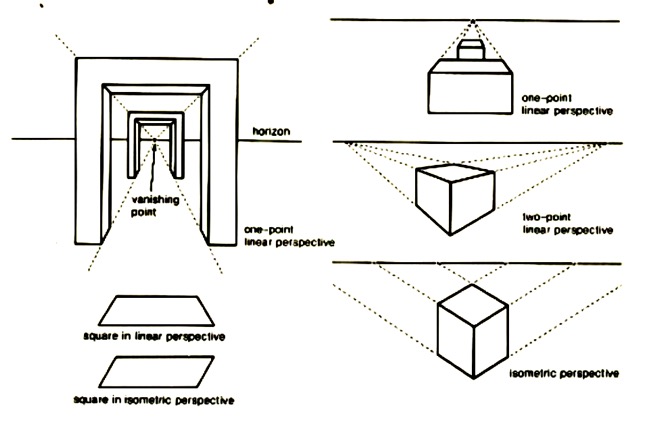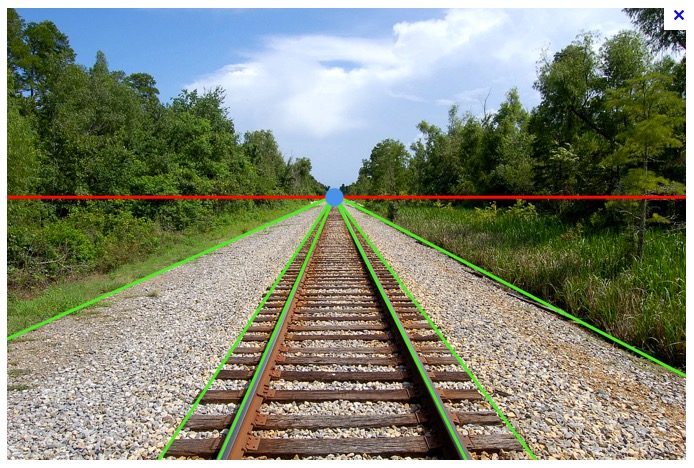Art Concept: Perspective. Perspective is another way of describing all the things that create the illusion of depth. Throughout time, artists have used many devices to create an illusion of depth or that the picture goes back, away from the picture plane or surface of the painting. Overlapping is one way to show depth because it shows that one thing is one front or behind another. Position is another way. Things on top or above, sometimes give the illusion that they are further back in space.
In the 15th century, Italian and Northern European artists perfected a scientific method of creating the illusion of space called “Linear and Atmospheric Perspective.” In linear perspective, the artist defines a horizon line. If all the lines slope in a parallel manner toward the horizon line, it is called isometric perspective. If the artist defines the horizon and a point on the horizon line called the vanishing point and all lines in the painting slope towards this point, it is called one-point perspective. Even more complex, an artist can have two vanishing points and create two point linear perspective.

Additional examples of one point perspective:

Red line identifies the horizon line, green slanting lines lead to the blue dot vanishing point.
.jpg)

Atmospheric perspective refers to the phenomenon created by the atmosphere where things farther away have fuzzier edges and duller colors. The sky is also lighter closer to the horizon than higher up in the sky. The next time you go outside, look and see if it’s true!
Look at the examples below and discuss what methods are used to show the illusion of depth. Ask if it is effective. Note that some artists purposefully ignore the rules of perspective. Why would they do that?

Boscoreale Ville, Second Style (Roman), 50BC. Early attempts at perspective. How well does it succeed?

Bihzad in the Garden, Jundain Indian Garden, 1396. Objects are stacked to show that they recede.

Medieval Dinner, King of Portuga,l John of Gaunt (French), manuscript 15th c. Isometric perspective.

Southern Barbarians, Momoyama Period (Japan), 16thc. Stacking and layering objects creates some illusion of space.

Limbourg Brothers, Le Tres Riche Heurs Duc De Berry (French), 1416. Early attempts at atmospheric perspective. Also, objects are smaller in the background.

Qui Ying Poets Gathering in the Peach and Pear Garden (China) 16thc. Isometric and stacking

Lal Sanwhlah Akbar, Hunting with trained Cheetas (Persian), 1590. No attempt at perspective – the design is everything here.

Dead Christ, Mantegna, 1466. Early attempt at foreshortening.

Songs without Words, Frederic Lord Leighton, 1860. Perfected foreshortening.

Perspective demonstration.

Annunciation, Rogier Van Der Weyden (Dutch), 1430. Early attempts at linear and atmospheric perspective.
.jpg)
School of Athens, Raphael (Italian), 1512. Perfected perspective.
.jpg)
Battista Sforza and Federica da Montefeltro, Piero Della Francesca (Italian), 1474. Perfected atmospheric perspective.

Gates of Paradise, Jacob and Esau Ghiberti (Italian),1435. Linear perspective in relief sculpture.

View of Mitsumata, Hiroshige (Japan) 1857. Atmospheric perspective

Huang Shan a Path Through the Clouds, Dennis Stanfill, 1991 and Rainstorm over Pavillion under Trees on River, Xia Gui (China), 13thc. Similar effects in perspective 600 years apart.

Allegory of Marriage of Rezzonico to Savorgnan, Tiepolo (Italian), 1758. Perspective gone wild!

The Persistence of Memory, Salvador Dali (Spain), 1931. Playing with perspective.

Detroit Industry, Diego Rivera (Mexico), 1932.

Dad’s Coming, Winslow Homer (American), 1873.
.jpg)
Mountain Travellers, Shen Zhou (French), 15thc.

California Highway, Robbins, 1936.

Brotherhood Building, Kroger Cincinnati, Richard Haas (American), 1983.

Escher, c. 1950. Manipulation of perspective.
Fueling Success for Every Student, Every School